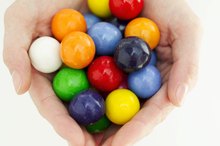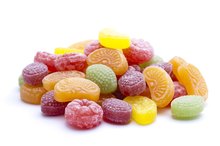Allergy to Red Dye in Drinks
Red dye is a food additive that causes allergy symptoms in some children and adults. Red dye is predominately found in prepackaged foods, especially candies, fruit snacks, cereals and gum. An intolerance to red dye may make you hyperactive, jittery or cause gastrointestinal problems. Allergy symptoms can range from mild to severe and usually include wheezing, coughing, hives, rash, swelling and runny nose. Consult an allergist if you think you may have an intolerance or allergy to red dye.
If you are experiencing serious medical symptoms, seek emergency treatment immediately.
Avoidance
According to the Food Allergy and Anaphylaxis Network, "strict avoidance of the allergy-causing food is the only way to prevent an allergic reaction." Examine food labels carefully. Red dye is sometimes labeled as such, but it can also appear as artificial coloring. Candy and treats such as gummy bears, lollipops and ice cream can contain red dye. Dye can also crop up in places you would not ordinarily think of, such as in cheeses, crackers or breads. Some liquid medications contain red dye. If you have an acute allergy to red dye, you may need to avoid some shampoos and lotions.
- According to the Food Allergy and Anaphylaxis Network, "strict avoidance of the allergy-causing food is the only way to prevent an allergic reaction."
- If you have an acute allergy to red dye, you may need to avoid some shampoos and lotions.
Symptoms
Blue 1 Side Effects
Learn More
Signs of an allergic reaction can appear within a few minutes or several hours after eating or drinking red dye. Allergic symptoms may include rash, hives, tingling or itching in the mouth. Sometimes, gastrointestinal problems such as vomiting, diarrhea or abdominal cramping occur. In rare cases, a life-threatening condition called anaphyalxis can develop. This emergency condition can inhibit breathing and requires immediate medical help.
- Signs of an allergic reaction can appear within a few minutes or several hours after eating or drinking red dye.
- In rare cases, a life-threatening condition called anaphyalxis can develop.
Prevalence
Dyes are being added to more and more foods and drinks 1. Despite the concerns of some, manufacturers add approximately 15 million lbs. of synthetic dyes to our foods each year, reports David Freeman on CBS News.com 1. "Per capita consumption of dyes has risen five-fold since 1955, thanks in part to the proliferation of brightly colored cereals, fruit drinks and candies," Freeman adds.
Allergic Response
Allergy to Yellow Dye
Learn More
An allergic reaction involves two main aspects of the immune system. The first is the allergy antibody called immunoglobulin E and the other is the mast cell, which stores up histamine. As histamine tries to clear your system of the allergen, it can cause a runny nose, itchy eyes and swelling of the lips or tongue. Your doctor can recommend over-the-counter or prescription medications to use in case you ingest red dye.
- An allergic reaction involves two main aspects of the immune system.
- As histamine tries to clear your system of the allergen, it can cause a runny nose, itchy eyes and swelling of the lips or tongue.
Related Articles
References
Writer Bio
Assia M. Mortensen has over 12 years of experience as an editor and journalist, and has published hundreds of articles in magazines, newspapers and online at "The Santa Barbara Independent," "Frontiers Magazine," "805 Living Magazine," Huffingtonpost.com, LIVESTRONG.COM and many other outlets. Mortensen graduated from the University of California in Santa Cruz with a Bachelor of Arts in literature and creative writing.









